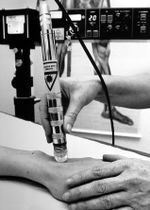Lateral Epicondyle Tendinopathy Toolkit: Section G - LASER Dosage Calculation: Difference between revisions
No edit summary |
No edit summary |
||
| Line 11: | Line 11: | ||
== Calculation of Dosage == | == Calculation of Dosage == | ||
In Laser devices that do not calculate Joules automatically, dose can be determined in seconds of exposure required to give the desired | In Laser devices that do not calculate Joules automatically, dose can be determined in seconds of exposure required to give the desired amount of energy by using the following calculation: | ||
*Joules = watts.seconds | *Joules = watts.seconds | ||
*hence, Seconds = Joules/watts | *hence, Seconds = Joules/watts | ||
'''For example''': | |||
* | *For a 50 mW Laser (= 0.050 Watts), with a required dose = 2 J per point | ||
* | *Seconds exposure = 2 / 0.05 = 40 secs<br> | ||
This change in parameters is very important clinically as the use of the previously recommended Joules/cm<sup>2</sup> resulted in confusion when | This change in parameters is very important clinically as the use of the previously recommended Joules/cm<sup>2</sup> resulted in confusion when comparing dosages between protocols. Also, the resultant dose in Joules/cm<sup>2</sup> could be the consequence of a number of different treatment options. | ||
{| width="700" border="1" align="center" cellpadding="1" cellspacing="1" | {| width="700" border="1" align="center" cellpadding="1" cellspacing="1" | ||
| Line 29: | Line 28: | ||
<span style="color:blue">For example, 4 J/cm<sup>2</sup> can be delivered by:</span> | <span style="color:blue">For example, 4 J/cm<sup>2</sup> can be delivered by:</span> | ||
'''Option | '''Option 1''' | ||
*a 20 mW Laser with a beam cross section of 0.5 cm<sup>2</sup> in 100 seconds | *a 20 mW Laser with a beam cross section of 0.5 cm<sup>2</sup> in 100 seconds | ||
*i.e. 4 = (0.02/0.5 x 100) | *i.e. 4 = (0.02/0.5 x 100) | ||
'''Option | |||
'''Option 2''' | |||
*a 10 mW laser with a beam cross‐section of 0.25 cm<sup>2</sup> in 100 seconds | *a 10 mW laser with a beam cross‐section of 0.25 cm<sup>2</sup> in 100 seconds | ||
*i.e. 4 = (0.01/0.25 x 100) | *i.e. 4 = (0.01/0.25 x 100) | ||
In '''Option 1''', the ''total energy delivered would be '''2 J''' '' | |||
In '''Option | In '''Option 2''', the ''total energy would be '''1 J''' '' | ||
|} | |} | ||
The example in the table above illustrates that using Joules/cm<sup>2</sup> resulted in one patient receiving ''twice ''the total amount of energy that is received by the other patient. | |||
Therefore, all physical therapists using LLLT should be delivering dosages based on Joules rather than Joules/cm<sup>2</sup>. | Therefore, all physical therapists using LLLT should be delivering dosages based on Joules rather than Joules/cm<sup>2</sup>. | ||
Revision as of 21:23, 22 October 2022
Introduction[edit | edit source]
Low level laser therapy (LLLT) is an electrotherapy modality used in the management of a broad spectrum of musculoskeletal conditions. It serves to stimulate healing, promote pain relief, manage inflammation and enhance the restoration of function in affected tissues[1].
Dosage of LLLT[edit | edit source]
LLLT, like other electrotherapy modalities, requires to be delivered at a certain dosage to produce its therapeutic effects. However, current recommendations specify that the dosage of LLLT be provided in Joules (J, implying total energy), rather than the previously recommended Joules/cm2 (J/cm2, which denoted energy density). Therefore, the use of Joules rather than Joules/cm2 is advocated to specify how much energy is delivered in a treatment.
Calculation of Dosage[edit | edit source]
In Laser devices that do not calculate Joules automatically, dose can be determined in seconds of exposure required to give the desired amount of energy by using the following calculation:
- Joules = watts.seconds
- hence, Seconds = Joules/watts
For example:
- For a 50 mW Laser (= 0.050 Watts), with a required dose = 2 J per point
- Seconds exposure = 2 / 0.05 = 40 secs
This change in parameters is very important clinically as the use of the previously recommended Joules/cm2 resulted in confusion when comparing dosages between protocols. Also, the resultant dose in Joules/cm2 could be the consequence of a number of different treatment options.
|
For example, 4 J/cm2 can be delivered by: Option 1
In Option 2, the total energy would be 1 J |
The example in the table above illustrates that using Joules/cm2 resulted in one patient receiving twice the total amount of energy that is received by the other patient.
Therefore, all physical therapists using LLLT should be delivering dosages based on Joules rather than Joules/cm2.
Using Joules rather than Joules/cm2 will enable better standardization of dosage and permit comparison across different
treatment regimes.
The World Association of Laser Therapy (WALT) provides dosage guidelines using Joules for various conditions. These
dosage guidelines are based upon the best evidence from the literature in conjunction with expert opinion.
Physical Therapists are encouraged to set LLLT dose according to the WALT guidelines found at:http://waltza.co.za/documentation-links/recommendations/dosage-recommendations/(Note that the WALT guidelines are given for surface exposure.)
Download Lateral Epicondyle Tendinopathy Toolkit: Appendix D - LASER Dosage Calculation[edit | edit source]
Acknowledgements[edit | edit source]
Developed by the BC Physical Therapy Tendinopathy Task Force: Dr. Joseph Anthony, Dr. Angela Fearon, Diana Hughes, Carol Kennedy, Dr. Alex Scott, Michael Yates, & Alison Hoens.
A Physical Therapy Knowledge Broker project supported by: UBC Department of Physical Therapy, Physiotherapy Association of BC, Vancouver Coastal Research Institute and Providence Healthcare Research Institute. June 2013
References[edit | edit source]
- ↑ Avci P, Gupta A, Sadasivam M, Vecchio D, Pam Z, Pam N, Hamblin MR. Low-level laser (light) therapy (LLLT) in skin: stimulating, healing, restoring. Semin Cutan Med Surg. 2013 Mar;32(1):41-52.







